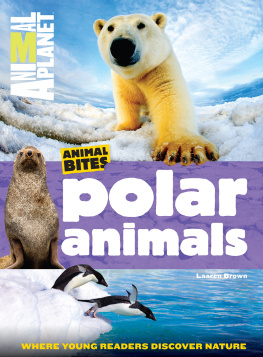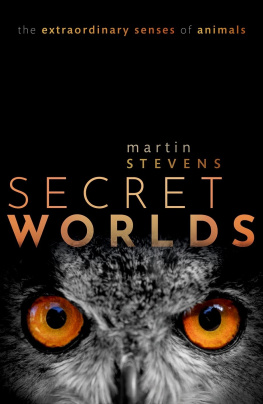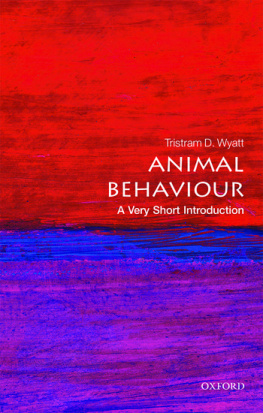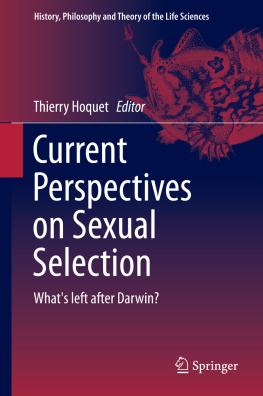A Taste for the Beautiful
A Taste for the Beautiful

The EVOLUTION of ATTRACTION

MICHAEL J. RYAN
PRINCETON UNIVERSITY PRESS
PRINCETON AND OXFORD
Copyright 2018 by Princeton University Press
All drawings by Emma Ryan 2017
Published by Princeton University Press, 41 William Street,
Princeton, New Jersey 08540
In the United Kingdom: Princeton University Press, 6 Oxford Street,
Woodstock, Oxfordshire OX20 1TR
press.princeton.edu
Jacket design by Andrea Guinn
Jacket images courtesy of Biodiversity Heritage Library, Flickr
All Rights Reserved
ISBN 978-0-691-16726-8
British Library Cataloging-in-Publication Data is available
This book has been composed in Adobe Caslon Pro
and F CaslonTwelve ITC for display
Printed on acid-free paper.
Printed in the United States of America
1 3 5 7 9 10 8 6 4 2
In memory of Stan Rand, fellow traveler
In appreciation of the
Smithsonian Tropical Research Institute
Contents

Chapter One
Why All the Fuss about Sex? 1
Chapter Two
Why All the Whining and Chucking? 13
Chapter Three
Beauty and the Brain 33
Chapter Four
Visions of Beauty 53
Chapter Five
The Sounds of Sex 77
Chapter Six
The Aroma of Adulation 105
Chapter Seven
Fickle Preferences 126
Chapter Eight
Hidden Preferences and Life in Pornotopia 148
Preface

I AM A SCIENTIST. This occupation affords me the opportunity to try to understand a small part of the natural world. I am also a professor. This occupation allows me to explain to others my findings in the context of the fields in which I work, animal behavior and evolution. My audience is usually college students and other scientists, although I often present lectures to a more general audience and quite frequently explain what I do to friends and family who do not have a background in science. I usually find that regardless of their background, many folks are interested in these stories of how sexual beauty plays out in nature and how our experiments in the laboratory give us insights into how and why sexual beauty evolved. My purpose in writing this book is to share these stories of sexual beauty, some from my research but mostly from others, with a much wider audience.
I owe a huge debt of gratitude to a large number of people. Marc Hauser first suggested that I write this book, and he has been a tough and constructive critic throughout all stages of its preparation. A stay as a Fellow at the Institute for Advanced Study (WIKO) in Berlin afforded me the opportunity to plan this book, and during the planning stage I benefited greatly from the feedback of Karin Akre; Robert Trivers; Idelle Cooper; Doug Emlen; Eric Lupfer, my agent at William Morris Enterprises; and Alison Kalett, my editor at Princeton University Press. Marc Hauser and Idelle Cooper read the entire manuscript, and Alison Kalett and Karin Akre did the same and also provided detailed editorial comments.
During the later stages of writing this book, I had a bad accident that left me in a wheelchair with a spinal cord injury. I would not have been able to complete this work without the expert and generous care at St. Davids Rehabilitation Hospital and Rehab Without Walls in Austin, Texas. I am eternally grateful to the staff of both of these organization, who I feel are part of a second family. During my time in the hospital, I received strong support and assistance on various tasks related to this book from Emma Ryan, Lucy Ryan, Marsha Berkman, Sofia Rodriguez, Idelle Cooper, Mirjam Amcoff, Fernando Mateos-Gonzalos, Karin Akre, Rachel Page, Caitlin Friesen, Tracy Burkhart, David Cannatella, May Dixon, Claire Hemingway, Ryan Taylor, and Kim Hunter. All of them are very special people.
My own research that I discuss in this book was funded by the National Science Foundation, the Smithsonian Institution, and the University of Texas. To each of these institutes I am most grateful.
A Taste for the Beautiful
ONE

Why All the Fuss about Sex?
The sight of a feather in a peacocks tail, whenever I gaze at it, makes me sick!
Charles Darwin

NATURE USUALLY GETS DOWN TO BUSINESS. Lets think about sleep. When I go to bed, I pull back the sheets, put my head on the pillow, and Im in dreamland. I do not have a sleeping ritual, I dont dance, sing, chant, or perfume myself. I just go to sleep. So do most animals. Eating is the same way. When a howler monkey finds an edible leaf, she plucks it and eats it; a heron just throws back his head and swallows the fish he speared out of the water; and a cheetah doesnt do a celebratory dance before she starts to devour the gazelle she just brought down, even though she sprinted at her personal best of 75 mph to do so. Granted, in our own species we can sometimes make a bigger deal out of eating, especially when a meal coincides with a special event. But for the most part, we are little different from the howler, the heron, and the cheetah. Take a bite, give it a good chew, and gulp it down. Much of life for most animals is like thatthe job is to just get it done.
Sex is different: a just-get-it-done policy wont get it done. In humans and most other animals, extensive courtship rituals precede the sex act. Most of our sexual rituals are laden with accessories, including candles and music, poems and flowers, and even special wardrobes. The list goes on, but it is no less diverse for animals. Animals sing and dance, they perfume themselves, they show off their colors and even light themselves up, all in the hope of attracting a mate. Although we distinguish ourselves in the language and technology we deploy in courtship, all animals have evolved spectacular, even obscene, morphologies and behaviors as both sexual lures and strategies for consummation. The colors of butterflies and fishes, the songs of insects and birds, the sexual odors of moths and mammals all evolved in the service of sex. The same is true for many of the traits in our own species that make women sigh and men gasp when someone of striking beauty crosses their paths. These aspects of sexual beauty evolved not because they make their bearers live longer but because they enable them to mate more and thus pass on more offspring and genes to the next generation.
Sexual beauty is everywhere, woven through the fabric of all sexually reproducing animals. We humans strive for beauty; we pay for it; we judge whether others have it; and if they do, we treat them better. Animals and humans both go to extreme lengths to appear beautiful to those who judge them. Peacocks evolve magnificent tails that cause peahens to sway, fishes sport bright colors that catch the eye of the other sex, crickets chirp endearingly to their mates, and spiders dance and vibrate their webs to show off. We humans take a more active role in engineering our beauty than do most other animals. Perfumes, fashion, cars, and music have all been employed in the service of sexual beauty, as have the surgeons knife and a pharmacopeia of drugs. But to enhance ones beauty, either through the painstakingly slow process of evolution or the more immediate gratification of beauty-engineering, one must have some notion of what is beautiful.
Next page













